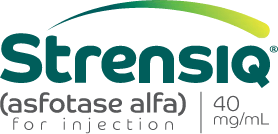
Juliana, Living with Hpp
STRENSIQ improves
bone health
By addressing the underlying cause of hypophosphatasia (HPP), STRENSIQ® (asfotase alfa) improves bone health. Healthier bones can lead to improved mobility in people living with HPP.
STUDIED IN ALL AGES
Bone health and mobilitya were studied in children and adults receiving treatment with STRENSIQ.
STRENSIQ was studied in children and adults, but only in those with signs and symptoms that appeared before 18 years of age.

Select secondary endpoints are in bold in the table above.
Abbreviations: PLP, pyridoxal 5'-phosphate (vitamin B6); PPi,
inorganic
pyrophosphate.
aMobility is a person’s ability to walk.
bHPP is when your body lacks sufficient ALP enzyme and you develop weak
or
“soft”
bones,
which may lead to skeletal deformities, tooth loss or pain, or other related symptoms.
cPPi and PLP are substances found in blood that are related to ALP
activity.
dGrowth refers to changes in body size based on age over time.
STRENSIQ IMPROVES SKELETAL HEALING
Study 1 and 2 primary endpoints
Improvements in HPP-related bone health/mineralization
Study 1 included patients up to three years of age with signs and symptoms that appeared before six months of age. At six months, 90% (9/10) of patients responded to treatment, which was sustained at seven years.
Study 2 included patients up to five years of age with signs and symptoms that appeared before six months of age. At six months, 58% (40/69) of patients responded to treatment, which was sustained at six years.
The primary endpoint is the outcome that establishes a medication’s effectiveness and safety when it goes through testing. The secondary endpoints demonstrate additional effects after success on the primary endpoint is shown.
Study 1
AFTER 6 MONTHS OF STRENSIQ
treatment achieved complete or substantial bone healing
AFTER 7 YEARS OF STRENSIQ
treatment achieved complete or substantial bone healing (7/7)
Study 2
AFTER 6 MONTHS OF STRENSIQ
treatment achieved complete or substantial bone healing
AFTER 6 YEARS OF STRENSIQ
treatment achieved complete or substantial bone healing (2/2)
SKELETAL HEALING
Study 3 primary endpoint
Improvements in HPP-related bone health/mineralization
Study 3 included patients from ages 6 years to 12 years that included perinatal/infantile- and juvenile-onset HPP patients.
At six months, 69% (9/13) of patients responded to treatment, which was sustained at seven years (12/12).
- one child did not complete this study
AFTER 6 MONTHS OF STRENSIQ
treatment achieved complete or substantial bone healing
AFTER 7 YEARS OF STRENSIQ
treatment achieved complete or substantial bone healing
STRENSIQ IMPROVES MOBILITY
Study 3 select secondary endpoints
Mobility
a6MWT is the distance walked measured over a 6-minute time period.
bThis refers to the percentage of the distance a healthy person of similar
age, sex, and
height would be expected to walk in 6 minutes.
cRepresentations of efficacy are consistent with results seen from typical
patients in the
study. Individual results may vary.
During the 6-minute walk test, a person is asked to walk as far as they can for 6 minutes. This test is helpful when determining if someone has trouble with mobility.
CHANGE IN PLASMA PPi AND PLP
Study 4 design
- Study 4 spanned five years and included adolescents and adults aged 13 to 65 years with signs and symptoms of HPP that appeared before 18 years of age (for 18 of the 19 study patients).
- The primary endpoints of this study were to measure reductions of PPi and PLP, which are substances found in the blood that are related to ALP enzyme activity and bone health. If PPi and PLP are high, ALP activity is generally low.
- Over the initial duration of the study, STRENSIQ was administered at lower doses than the FDA-approved dose (weight-based dose of 6 mg/kg per week).
- The most frequently reported adverse events were injection-site reactions.
- This data is not included in the FDA-approved Prescribing Information.
MOBILITY AS MEASURED BY THE 6-MINUTE WALK TEST (6MWT)
Study 4 select secondary endpoint
Mobility
*This refers to the percentage of the distance a healthy person of similar age, sex, and height would be expected to walk in 6 minutes.
STRENSIQ SIDE EFFECTS
Adverse reactions reported in at least 10% of patients with perinatal/infantile- or juvenile-onset HPP enrolled in STRENSIQ clinical trials

aAdverse reactions are from the combined period of 6 mg/kg and above (ie, total drug exposure regardless of starting dose and intermediary doses as long as the patient reached doses >6 mg/kg)

HPP PATIENT SUPPORT
Enroll in OneSource™ to get personalized patient support from Alexion at 1.888.765.4747.
Learn More about OneSource™

AT ONESOURCE, WE ARE BY YOUR SIDE THROUGHOUT YOUR JOURNEY, FROM LEARNING ABOUT YOUR CONDITION TO HELPING YOU ACCESS THE THERAPY YOU'VE BEEN PRESCRIBED. PATIENTS' NEEDS ARE OUR TOP PRIORITY.
–Deana,
ONESOURCE CASE MANAGER


Ready to get started with strensiq?
Once your doctor prescribes STRENSIQ, Alexion and OneSource™ will be there to guide you on your STRENSIQ treatment journey. See the resources available as you start treatment with STRENSIQ.
What is the most important information I should know about STRENSIQ® (asfotase alfa)?
STRENSIQ may cause serious side effects, including severe allergic (hypersensitivity) reactions. Allergic reactions are common with STRENSIQ treatment and can be severe and life-threatening. Severe allergic reactions have happened in some people within minutes after receiving STRENSIQ and more than 1 year after starting treatment with STRENSIQ. Stop using STRENSIQ and go to the nearest hospital emergency room right away if you or your loved one get any of the following signs and symptoms of a serious allergic reaction:
- difficulty breathing
- choking sensation
- swelling of your eyes, lips, or tongue
- dizziness
- nausea or vomiting
- fever
- headache
- sweating
- feeling irritable
- chills
- skin redness
- skin rash or hives
-
itching or numbness of the
tongue, lips, cheeks, or gums
What are the other possible side effects of STRENSIQ?
STRENSIQ may cause other serious side effects, including:
- skin thickening or pits at the injection site (lipodystrophy). Lipodystrophy is common and has happened after several months in people treated with STRENSIQ.
- calcium build-up in the eyes and kidneys. People with HPP are at increased risk for developing calcium build-up in the body. Calcium build-up in the eyes and kidneys has happened and is a common side effect of STRENSIQ. Calcium build-up in the eyes and kidneys may also happen in people with HPP who are not treated with STRENSIQ. Your healthcare provider should check your eyes and kidneys before and during treatment with STRENSIQ.
- immune-related effects. You may develop antibodies during treatment that may decrease how well STRENSIQ works. Tell your healthcare provider right away if you get worsening symptoms of HPP including: difficulty breathing, difficulty walking, feeling tired, bone pain, stiff joints, or loss of appetite.
The most common side effects of STRENSIQ include local skin injection site reactions such as skin redness, bruising, color change, pain, itching, hardening of the skin (induration), swelling, and bumps. These are not all the possible side effects of STRENSIQ. For more information, ask your healthcare provider or pharmacist. Call your healthcare provider for medical advice about side effects.
You will begin receiving STRENSIQ under the supervision of a healthcare provider. Tell your healthcare provider about all your medical conditions, including if
you:
- have had an allergic reaction to STRENSIQ.
- are pregnant or plan to become pregnant. It is not known if STRENSIQ will harm your unborn baby.
- are breastfeeding or plan to breastfeed. It is not known if STRENSIQ passes into your breast milk. Talk to your healthcare provider about the best way to feed your baby if you use STRENSIQ.
Tell your healthcare provider about all the
medicines you
take,
including
prescription and over-the-counter medicines,
vitamins, and herbal
supplements.
There is a registry for people who use STRENSIQ. The purpose of this registry is to collect information about HPP and about what happens when you use STRENSIQ for a long time. For more information about this registry, talk with your healthcare provider or go to www.hppregistry.com.
To report SUSPECTED SIDE EFFECTS, contact Alexion
Pharmaceuticals, Inc. at
1-844-259-6783 or FDA at
1-800-FDA-1088
or
www.fda.gov/
medwatch.
INDICATION
What is STRENSIQ?
STRENSIQ® (asfotase alfa) is a prescription medicine
used to
treat people
with perinatal, infantile, and juvenile onset
hypophosphatasia (HPP).
Please see the full Prescribing Information and Patient Information, including Boxed WARNING regarding severe allergic (hypersensitivity) reaction.
What is the most important information I should know about STRENSIQ® (asfotase alfa)?
STRENSIQ may cause serious side effects, including severe allergic (hypersensitivity) reactions. Allergic reactions are common with STRENSIQ treatment and can be severe and life-threatening. Severe allergic reactions have happened in some people within minutes after receiving STRENSIQ and more than 1 year after starting treatment with STRENSIQ. Stop using STRENSIQ and go to the nearest hospital emergency room right away if you or your loved one get any of the following signs and symptoms of a serious allergic reaction:
- difficulty breathing
- choking sensation
- swelling of your eyes, lips, or tongue
- dizziness
- nausea or vomiting
- fever
- headache
- sweating
- feeling irritable
- chills
- skin redness
- skin rash or hives
-
itching or numbness of the
tongue, lips, cheeks, or gums
What are the other possible side effects of STRENSIQ?
STRENSIQ may cause other serious side effects, including:
- skin thickening or pits at the injection site (lipodystrophy). Lipodystrophy is common and has happened after several months in people treated with STRENSIQ.
- calcium build-up in the eyes and kidneys. People with HPP are at increased risk for developing calcium build-up in the body. Calcium build-up in the eyes and kidneys has happened and is a common side effect of STRENSIQ. Calcium build-up in the eyes and kidneys may also happen in people with HPP who are not treated with STRENSIQ. Your healthcare provider should check your eyes and kidneys before and during treatment with STRENSIQ.
- immune-related effects. You may develop antibodies during treatment that may decrease how well STRENSIQ works. Tell your healthcare provider right away if you get worsening symptoms of HPP including: difficulty breathing, difficulty walking, feeling tired, bone pain, stiff joints, or loss of appetite.
The most common side effects of STRENSIQ include local skin injection site reactions such as skin redness, bruising, color change, pain, itching, hardening of the skin (induration), swelling, and bumps. These are not all the possible side effects of STRENSIQ. For more information, ask your healthcare provider or pharmacist. Call your healthcare provider for medical advice about side effects.
You will begin receiving STRENSIQ under the supervision of a healthcare provider. Tell your healthcare provider about all your medical conditions, including if
you:
- have had an allergic reaction to STRENSIQ.
- are pregnant or plan to become pregnant. It is not known if STRENSIQ will harm your unborn baby.
- are breastfeeding or plan to breastfeed. It is not known if STRENSIQ passes into your breast milk. Talk to your healthcare provider about the best way to feed your baby if you use STRENSIQ.
Tell your healthcare provider about all the
medicines you
take,
including
prescription and over-the-counter medicines,
vitamins, and herbal
supplements.
There is a registry for people who use STRENSIQ. The purpose of this registry is to collect information about HPP and about what happens when you use STRENSIQ for a long time. For more information about this registry, talk with your healthcare provider or go to www.hppregistry.com.
To report SUSPECTED SIDE EFFECTS, contact Alexion
Pharmaceuticals, Inc. at
1-844-259-6783 or FDA at
1-800-FDA-1088
or
www.fda.gov/
medwatch.
INDICATION
What is STRENSIQ?
STRENSIQ® (asfotase alfa) is a prescription medicine
used to
treat people
with perinatal, infantile, and juvenile onset
hypophosphatasia (HPP).
Please see the full Prescribing Information and Patient Information, including Boxed WARNING regarding severe allergic (hypersensitivity) reaction.



 CHILDREN
CHILDREN



